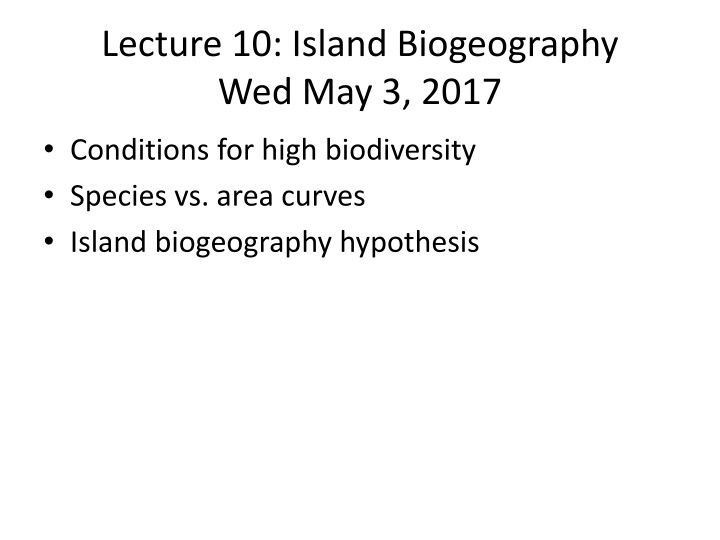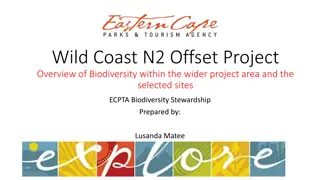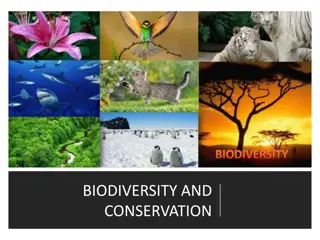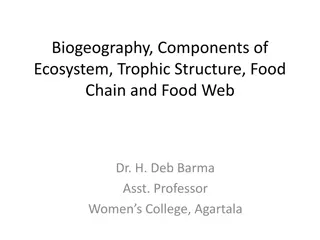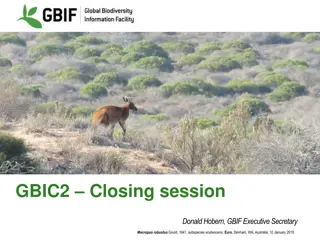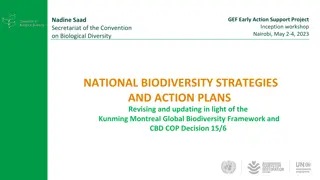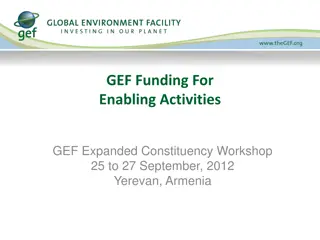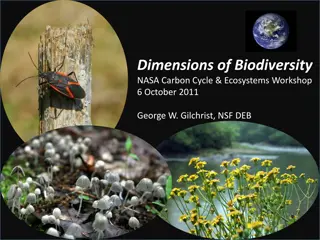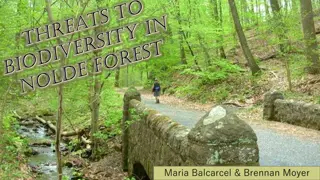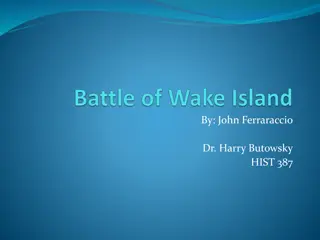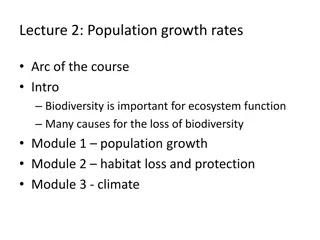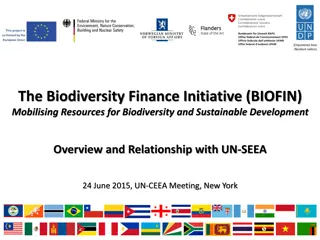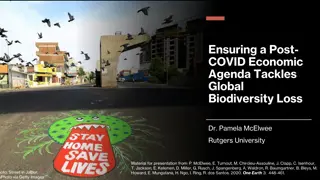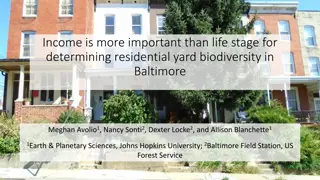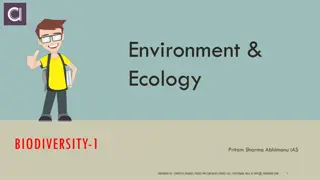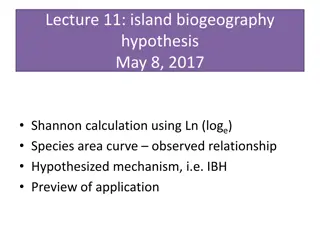Island Biogeography and Biodiversity Factors
Explore the relationship between island size, distance from other communities, latitude, and time in relation to species richness and biodiversity. Factors influencing biodiversity are discussed in the context of island biogeography hypothesis. Analysis of species vs. area curves is presented, highlighting the impact of island size on species diversity.
Download Presentation

Please find below an Image/Link to download the presentation.
The content on the website is provided AS IS for your information and personal use only. It may not be sold, licensed, or shared on other websites without obtaining consent from the author.If you encounter any issues during the download, it is possible that the publisher has removed the file from their server.
You are allowed to download the files provided on this website for personal or commercial use, subject to the condition that they are used lawfully. All files are the property of their respective owners.
The content on the website is provided AS IS for your information and personal use only. It may not be sold, licensed, or shared on other websites without obtaining consent from the author.
E N D
Presentation Transcript
Lecture 10: Island Biogeography Wed May 3, 2017 Conditions for high biodiversity Species vs. area curves Island biogeography hypothesis
What factors are related to species richness?
Four factors that relate to biodiversity From text what are they
Four factors Latitude Time Habitat size Distance from other communities
Species and Area Steffan-Dewenter & Tscharntke 2000:
Species and Area #Individ uals/sp Reach# SpeciesFoundInSample 1 Bluntnose minnow 1 Gizzard shad 1 Longnose gar 2 Bluntnose minnow 2 Common carp 2 Gizzard shad 2 Mimic shiner 3 Golden redhorse 3 Shorthead redhorse 3 Bluntnose minnow 3 Longnose gar 4 Gizzard shad 4 Golden redhorse 4 Longnose gar 4 Spotfin shiner 5 Gizzard shad 5 Quillback 5 Mimic shiner 5 Shorthead redhorse 8 11 4 9 8 18 6 16 12 3 3 21 14 2 9 14 5 8 8 Example: Fish found in Kankakee River, Illinois (species from Kwak & Peterson 2007)
Species and Area #Individ uals/sp Reach# SpeciesFoundInSample 1 Bluntnose minnow 1 Gizzard shad 1 Longnose gar 2 Bluntnose minnow 2 Common carp 2 Gizzard shad 2 Mimic shiner 3 Golden redhorse 3 Shorthead redhorse 3 Bluntnose minnow 3 Longnose gar 4 Gizzard shad 4 Golden redhorse 4 Longnose gar 4 Spotfin shiner 5 Gizzard shad 5 Quillback 5 Mimic shiner 5 Shorthead redhorse 8 10-1. Graph the species- area curve. 11 4 9 8 18 6 16 12 3 3 21 14 2 9 14 5 8 8 Species Richness 1 2 3 4 5 Number of Reaches
Species and Area #Individ uals/sp Reach# SpeciesFoundInSample 1 Bluntnose minnow 1 Gizzard shad 1 Longnose gar 2 Bluntnose minnow 2 Common carp 2 Gizzard shad 2 Mimic shiner 3 Golden redhorse 3 Shorthead redhorse 3 Bluntnose minnow 3 Longnose gar 4 Gizzard shad 4 Golden redhorse 4 Longnose gar 4 Spotfin shiner 5 Gizzard shad 5 Quillback 5 Mimic shiner 5 Shorthead redhorse 8 Q5. Graph the species- area curve. 11 4 9 8 18 6 16 12 3 3 21 14 2 9 14 5 8 8
Species and Area #Individ uals/sp Reach# SpeciesFoundInSample 1 Bluntnose minnow 1 Gizzard shad 1 Longnose gar 2 Bluntnose minnow 2 Common carp 2 Gizzard shad 2 Mimic shiner 3 Golden redhorse 3 Shorthead redhorse 3 Bluntnose minnow 3 Longnose gar 4 Gizzard shad 4 Golden redhorse 4 Longnose gar 4 Spotfin shiner 5 Gizzard shad 5 Quillback 5 Mimic shiner 5 Shorthead redhorse 8 10-2. Group: How is this useful? For sampling? For conservation? 11 4 9 8 18 6 16 12 3 3 21 14 2 9 14 5 8 8
Species-Area Curves Log area is common. For example, as area gets 10 times bigger, increase in species by roughly 50% No matter where you start
Species-Area Curves This idea has been generalized: S = C * AZ S = species richness C = a taxonomic specific constant (species/area) A = Area Z = similar for many islands, typically < 0.1
Species Richness as a Function of Distance
Island Biogeography EO Wilson s studies on ants led to the theory of island biogeography. Every 10x increase in island area led to a 2x increase in the number of ant species (ant S). An equilibrium ant S on an each island: ant S depends on island size & distance from source Teamed w/ MacArthur to make theory: 1963
Island Biogeography MacArthur & Wilson 1963 MacArthur & Wilson (1963) islands off New Guinea From Cain et al. Ecology.
Island Biogeography Theory S Lowest As distance increases, S decreases. Mainland As area increases, S increases. S Highest
Island Biogeography Theory Examine equilibrium number of species Area effect: Larger islands support higher S due to more complex habitat and lower extinction rates due to larger populations. Isolation effect: Nearer islands support higher S due to greater immigration and recolonization rates.
Island Biogeography Theory MacArthur and Wilson 1967 Number of Species Time Why time? What does this represent?
Island Biogeography Theory Near Rate of Immigration Far Number of Species MacArthur and Wilson 1967
Island Biogeography Theory Small Rate of Extinction Large Number of Species MacArthur and Wilson 1967
Island Biogeography Theory If we have species immigration rate and species extinction rate, we can calculate S. S = Immigration Extinction Equilibrium S occurs when Immigration = Extinction (Note the similarity to population growth = b d + i e)
Island Biogeography Theory Small Island Near Mainland Far Large Rate of Extinction Rate of Immigration Equilibrium Number of Species (S) What Does Equilibrium Mean? MacArthur and Wilson 1967
Island Biogeography Theory MacArthur and Wilson 1967
Island Biogeography Theory Small Island Far from Mainland Rate of Extinction Rate of Immigration Number of Species (S) MacArthur and Wilson 1967
Island Biogeography Theory Near Mainland Large Island Rate of Extinction Rate of Immigration Number of Species (S) MacArthur and Wilson 1967
Island Biogeography Theory Rate of Extinction Rate of Immigration Number of Species (S) 10-3. Fill in the graph for near the mainland, small island. Relatively how many species (high, medium-high, medium, medium-low, low)?
Island Biogeography Does island biogeography apply to habitat islands on continents? Why do islands start with fewer- than predicted species at small areas compared with continents? From Cain et al. Ecology.
Island Biogeography Can theory can be applied to habitat islands on larger land masses? Examples?
Species and Area W.D.Newmark Conservation Biology 1995: Rate of mammal extinction in western parks.
